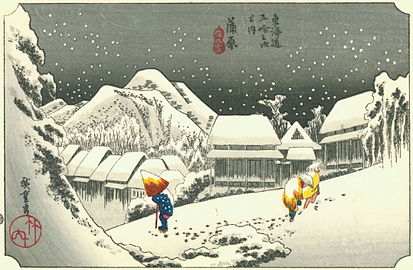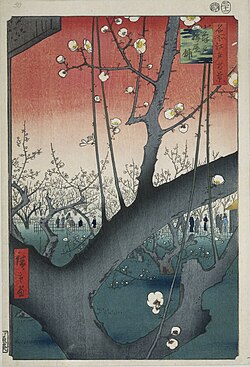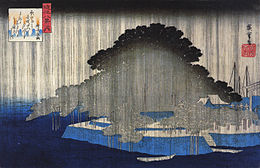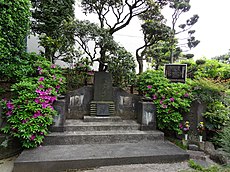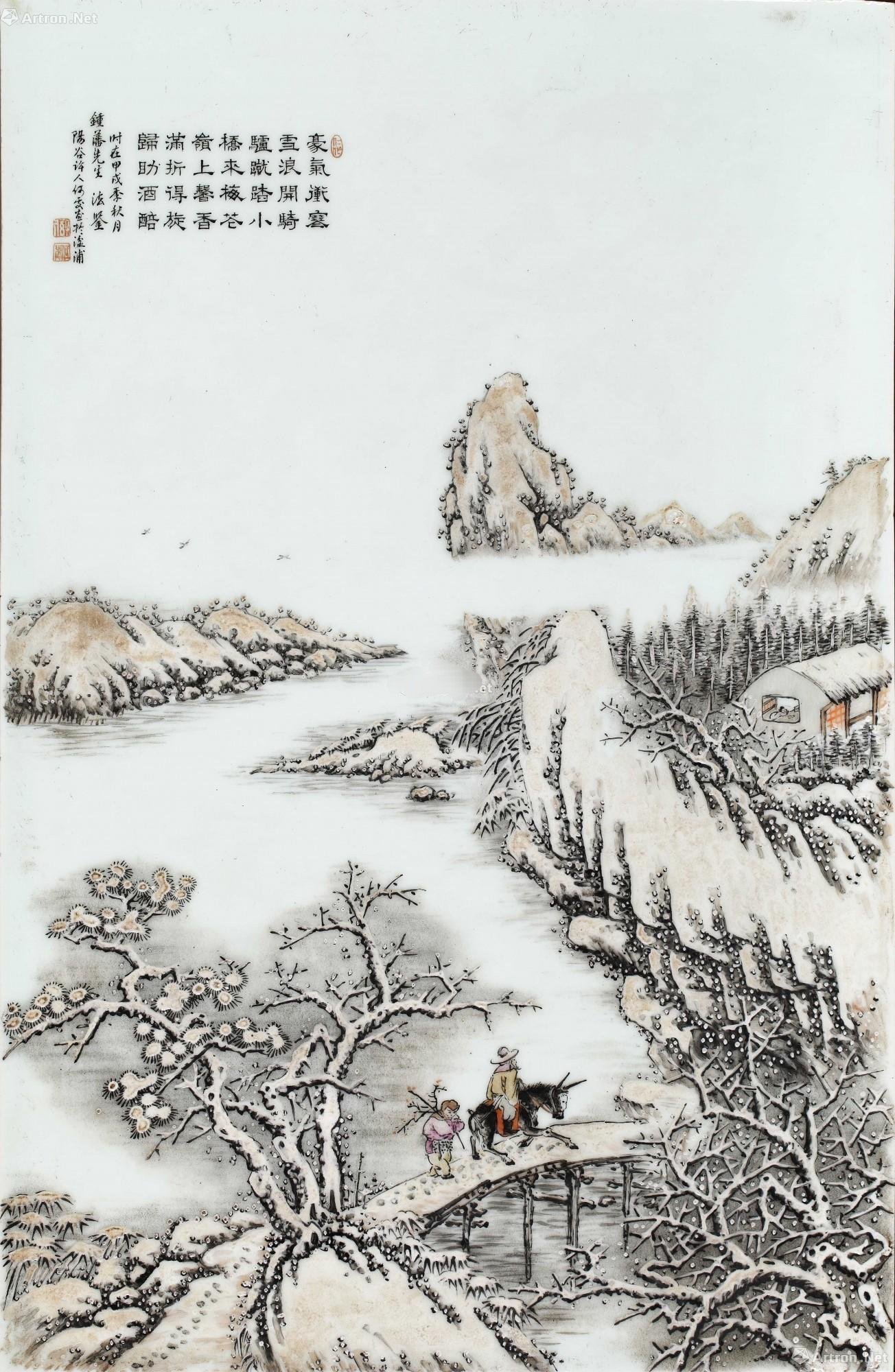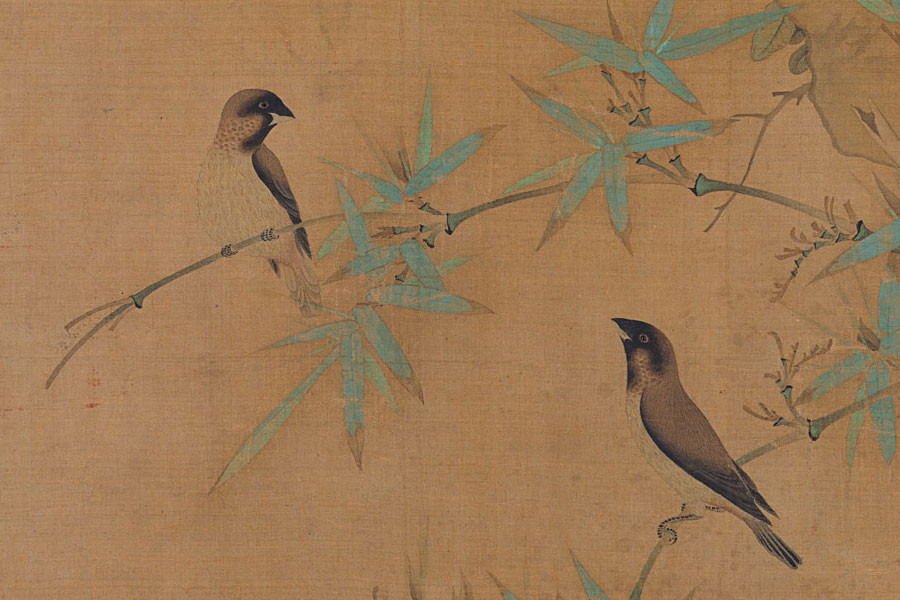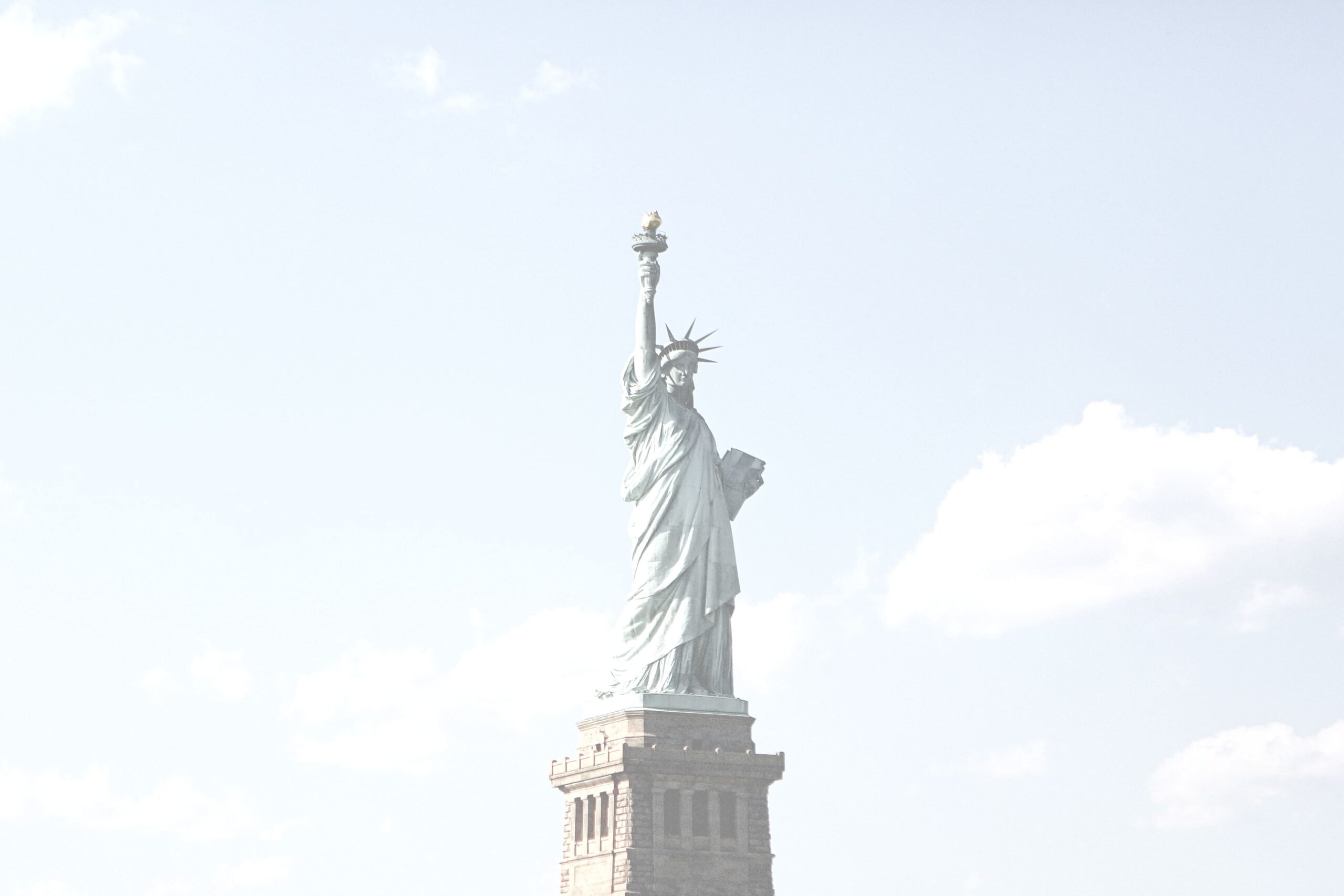如果说葛饰北斋是狂歌放诞型的画家,而广重却是地道的日本风味,内敛,优美,还带有一丝茕茕独行的寂寥。
歌川广重原姓为安腾,后来因为投入歌川派门下所以改为“歌川”名号。歌川派是一个非常庞大的画派,影响力深远,门下也出了很多天才型画家,比如爱猫成痴的歌川国芳,以及堪称鬼才的月岗芳年。
“浮世绘的笔触如此之快,快到像光。这就是日本人的风貌:他们的神经更纤细,情感更直接。”梵高迷恋广重,以至于模仿了许多画作,说是师承之一便是广重也不为过。广重最后的杰作是《名所江户百景》。梵高最著名的几幅仿作大多出自这系列。
 Sudden Shower Over Shin-Ohashi Bridge and Atake, Hiroshige, 1857
Sudden Shower Over Shin-Ohashi Bridge and Atake, Hiroshige, 1857
 Bridge in the rain (after Hiroshige), Vincent van Gogh (from Japonaiserie), oil on canvas, 1887
Bridge in the rain (after Hiroshige), Vincent van Gogh (from Japonaiserie), oil on canvas, 1887
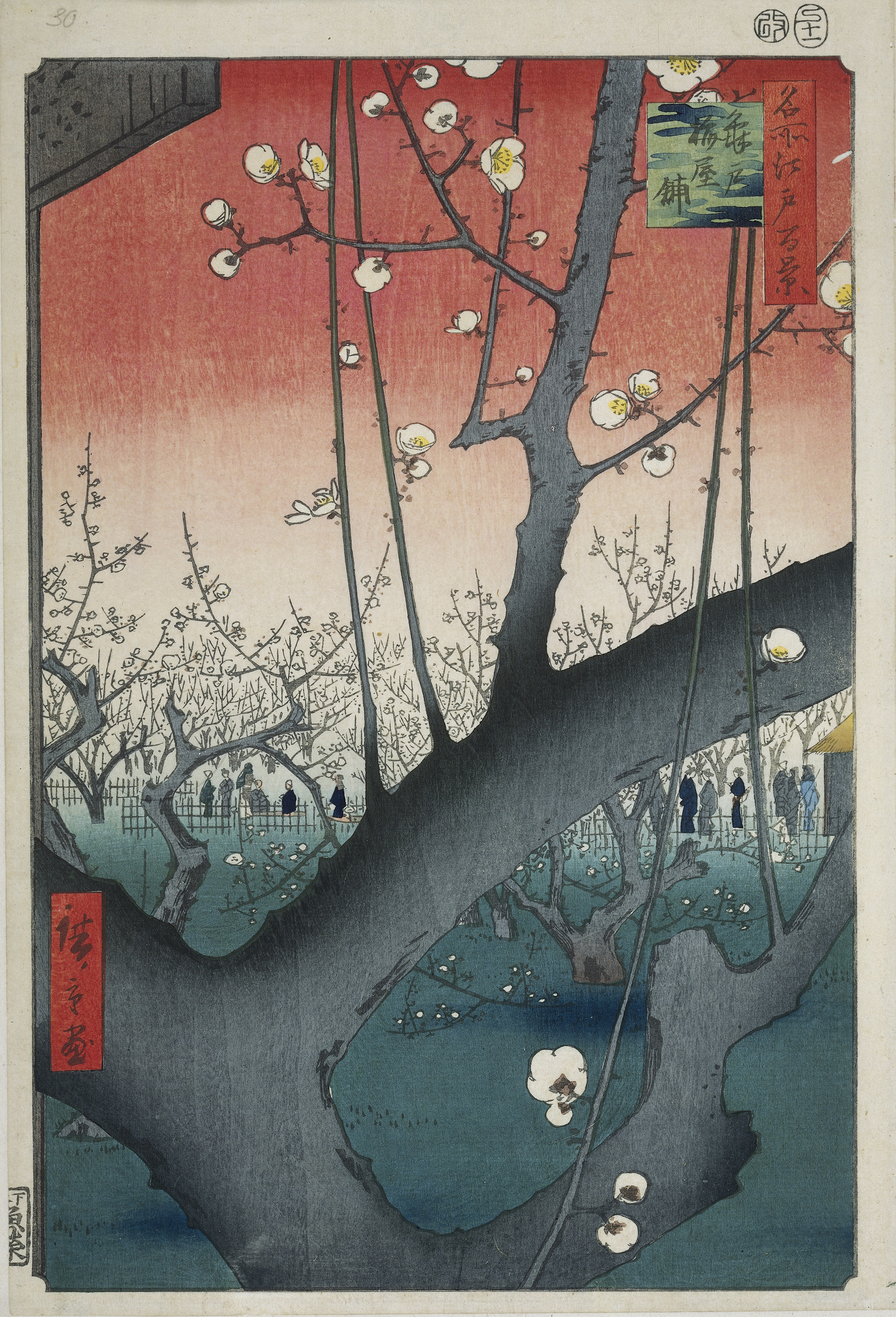 The Plum Garden in Kameido (1857), from Hiroshige’s One Hundred Famous Views of Edo
The Plum Garden in Kameido (1857), from Hiroshige’s One Hundred Famous Views of Edo
 Flowering Plum Tree (after Hiroshige) (1887) by Vincent van Gogh, from his Japonaiserie, in the collection of the Van Gogh Museum in Amsterdam
Flowering Plum Tree (after Hiroshige) (1887) by Vincent van Gogh, from his Japonaiserie, in the collection of the Van Gogh Museum in Amsterdam
广重是日式的风花雪月,区别于北斋的烂漫直接,他的画里是对人间世相文人式超凡脱俗的咏叹。这当中更多的精神内核是物之哀,落花静,人独立。这种和歌式哀寂的风味辅以浮世绘活泼浓烈的表达,代表着纯日式艺术表达的最高水平之一,赋以浮世绘这个市民艺术诗性禅意的一面。
歌川广重技法、心性的修为都相当高,形意皆妙,借鉴一切世间法,化用于笔下。以其敏锐启发了梵高,两人是东西洋美术隔空呼应的一段有趣的因缘。



部分文字来源于 琉花君 的阅读专栏 | 聊艺术
| 歌川广重 | |
|---|---|
 | |
| 出生 | 1797年 |
| 逝世 | 1858年10月12日(60—61歲) |
| 国籍 | |
| 知名于 | 浮世绘 |
| 知名作品 | 《東海道五十三次》《六十余州名所図会》《名所江戸百景》 |
| 日語寫法 | |
|---|---|
| 日語原文 | 歌川 廣重 |
| 假名 | うたがわ ひろしげ |
| 平文式罗马字 | Utagawa Hiroshige |
歌川廣重(日语:歌川 廣重/うたがわ ひろしげ Utagawa Hiroshige,1797年—1858年10月12日)是日本浮世繪畫家[1]。
生平
[编辑]出身於江戶(现东京)的一個消防員家庭[1],1811年他在江户成为浮世绘大师歌川丰广的学生。他于1833~1834年间的55幅风景画系列《东海道五十三次》确立了他作为有史以来最受欢迎的浮世绘画家之一的地位。由于对他的人物风景画需求太多,大量制作降低了风景画的品質。他创作了5000多幅画,还从他的一些木刻作品上复制出了1万幅。他的天赋最先被西方的印象派和后印象派画家认同,广重也从他们那里受到了很大的影响。
歌川廣重的風格較為親民、清麗,而有小品風範,在日本當時,是民間家喻戶曉的知名畫家。他的作品主要皆為風景繪,可以歸類到日本浮世繪中的名所繪類別,他把江戶所有熟悉的一草一木都劃進畫布當中,像是神田染屋。
在1830年代,他開始畫更多各式各樣的自然風景,在當時的江戶興起一股遊賞風氣,可能跟當時政治背景相關,因為文人在仕途上的不得意,所以文人們開始會到寺廟/茶舍進行參拜。
歌川廣重的繪畫風格
[编辑]寓人手法
[编辑]雖然主要的繪圖主題是風景,但他會在畫面上加入小人物的日常生活描繪,增添畫面的生動感。
四季情景的描繪
[编辑]這是他所擅長的表現手法,利用明暗、陰暗等技巧的呈現,可以在他的作品中感受到季節轉換的感覺。
作品
[编辑]- 《東海道五十三次》(錦繪、55幅)
- 《金澤之月夜》、《阿波之鳴門》、《木曾雪景》(大錦繪各3幅)
- 《金澤八景》(8幅)
- 《京都名所》、《浪花名所》(各10幅)
- 《近江八景》
- 《江戶近郊八景》
- 《東都名所》
- 《富士三十六景》
- 《六十余州名所圖會》(70幅)
- 《木曾街道六十九次》
- 《甲陽猿橋》、《富士川雪景》(直立各2幅)
- 《名所江戶百景》(大型直立118幅和封面1幅)
- 《大橋安宅驟雨》
- 《繪本江戶土產》(插繪)
- 東海道五十三次
-
箱根 湖水圖
-
蒲原 夜之雪
-
庄野 白雨
特色
[编辑]- 在東海道五十三次的作品系列,他善用寫生筆法,加入寓人手法,把各種從事活動的小人物都融入他的畫中。
- 近江八景:在滋賀縣內所繪的八幅風景圖
参考文献
[编辑]近江八景(おうみ はっけい)是日本近江国(现・滋贺县)的风景中选定的“八景”。
八景
[编辑]- 石山秋月(いしやま の しゅうげつ Ishiyama no Shōgetsu) - 石山寺
- 势多(濑田)夕照(せた の せきしょう Seta no sekishō) - 濑田唐桥
- 粟津晴岚(あわづ の せいらん Awazu no seiran) - 粟津原
- 矢桥帰帆(やばせ の きはん Yabase no kihan) - 矢桥
- 三井晩钟(みい の ばんしょう Mii no banshō) - 三井寺(园城寺)
- 唐崎夜雨(からさき の やう Karasaki no yau) - 唐崎神社
- 坚田落雁(かたた の らくがん Katata no rakugan) - 浮御堂
- 比良暮雪(ひら の ぼせつ Hira no bosetsu) - 比良山系
歌川广重 ‘近江八景’
[编辑]江户后期的浮世绘师・歌川广重描绘的名所绘(浮世绘风景画)‘近江八景’是广重的代表作之一,也是近江八景的代表作。全8图。
 |
 |
 |
 |
 |
 |
 |
 |
模仿近江八景的庭园
[编辑]关连项目
[编辑]外部链接
[编辑]
Hiroshige | |
|---|---|
| 広重 | |
 Memorial portrait of Hiroshige by Kunisada | |
| Born | Andō Tokutarō 1797 |
| Died | 12 October 1858 (aged 60–61) Edo, Japan |
| Nationality | Japanese |
| Education | Toyohiro |
| Known for | |
| Notable work | |
| Movement | Utagawa school |
Utagawa Hiroshige (/ˌhɪəroʊˈʃiːɡeɪ/, also US: /ˌhɪərəˈ-/;[1][2] Japanese: 歌川 広重 [ɯtaɡawa çiɾoꜜɕiɡe]), born Andō Tokutarō (安藤 徳太郎; 1797 – 12 October 1858), was a Japanese ukiyo-e artist, considered the last great master of that tradition.
Hiroshige is best known for his horizontal-format landscape series The Fifty-three Stations of the Tōkaidō and for his vertical-format landscape series One Hundred Famous Views of Edo. The subjects of his work were atypical of the ukiyo-e genre, whose typical focus was on beautiful women, popular actors, and other scenes of the urban pleasure districts of Japan's Edo period (1603–1868). The popular series Thirty-six Views of Mount Fuji by Hokusai was a strong influence on Hiroshige's choice of subject, though Hiroshige's approach was more poetic and ambient than Hokusai's bolder, more formal prints. Subtle use of color was essential in Hiroshige's prints, often printed with multiple impressions in the same area and with extensive use of bokashi (color gradation), both of which were rather labor-intensive techniques.
For scholars and collectors, Hiroshige's death marked the beginning of a rapid decline in the ukiyo-e genre, especially in the face of the westernization that followed the Meiji Restoration of 1868. Hiroshige's work came to have a marked influence on western European painting towards the close of the 19th century as a part of the trend in Japonism. Western European artists, such as Manet and Monet, collected and closely studied Hiroshige's compositions: Vincent van Gogh, for instance, painted copies of some Hiroshige prints.
Early life and apprenticeship
[edit]

Returning Sails at Tsukuda, from Eight Views of Edo, early-19th century
Hiroshige was born in 1797 in the Yayosu Quay section of the Yaesu area in Edo (modern Tokyo).[3] He was of a samurai background,[3] and is the great-grandson of Tanaka Tokuemon, who held a position of power under the Tsugaru clan in the northern province of Mutsu. Hiroshige's grandfather, Mitsuemon, was an archery instructor who worked under the name Sairyūken. Hiroshige's father, Gen'emon, was adopted into the family of Andō Jūemon, whom he succeeded as fire warden for the Yayosu Quay area.[3]
Hiroshige went through several name changes as a youth: Jūemon, Tokubē, and Tetsuzō.[3] He had three sisters, one of whom died when he was three. His mother died in early 1809, and his father followed later in the year, but not before handing his fire warden duties to his twelve-year-old son.[4] He was charged with prevention of fires at Edo Castle, a duty that left him much leisure time.[5]
Not long after his parents' deaths, perhaps at around fourteen, Hiroshige—then named Tokutarō— began painting.[4][6] He sought the tutelage of Toyokuni of the Utagawa school, but Toyokuni had too many pupils to make room for him.[5] A librarian introduced him instead to Toyohiro of the same school.[7] By 1812 Hiroshige was permitted to sign his works, which he did under the art name Hiroshige.[4] He also studied the techniques of the well-established Kanō school, the nanga whose tradition began with the Chinese Southern School, and the realistic Shijō school, and likely the linear perspective techniques of Western art and uki-e.[8]
Hiroshige's apprentice work included book illustrations and single-sheet ukiyo-e prints of female beauties and kabuki actors in the Utagawa style, sometimes signing them Ichiyūsai[9] or, from 1832, Ichiryūsai.[10] In 1823, he passed his post as fire warden on to his son,[11] though he still acted as an alternate.[a] He declined an offer to succeed Toyohiro upon the master's death in 1828.[5]
Landscapes, flora, and fauna
[edit]It was not until 1829–1830 that Hiroshige began to produce the landscapes he has come to be known for, such as the Eight Views of Ōmi series.[12] He also created an increasing number of bird and flower prints about this time.[10] About 1831, his Ten Famous Places in the Eastern Capital appeared, and seem to bear the influence of Hokusai, whose popular landscape series Thirty-six Views of Mount Fuji had recently seen publication.[13]
An invitation to join an official procession to Kyoto in 1832 gave Hiroshige the opportunity to travel along the Tōkaidō route that linked the two capitals. He sketched the scenery along the way, and when he returned to Edo he produced the series The Fifty-three Stations of the Tōkaidō, which contains some of his best-known prints.[13] Hiroshige built on the series' success by following it with others, such as the Illustrated Places of Naniwa (1834), Famous Places of Kyoto (1835), another Eight Views of Ōmi (1834). As he had never been west of Kyoto, Hiroshige-based his illustrations of Naniwa (modern Osaka) and Ōmi Province on pictures found in books and paintings.[14]
- Selections from The Fifty-three Stations of the Tōkaidō
-
Print 11: Hakone
-
Print 16: Kanbara
-
Print 46: Rain Shower at Shōno
Hiroshige's first wife helped finance his trips to sketch travel locations, in one instance selling some of her clothing and ornamental combs. She died in October 1838, and Hiroshige remarried to Oyasu,[b] sixteen years his junior, daughter of a farmer named Kaemon from Tōtōmi Province.[15]
Around 1838 Hiroshige produced two series entitled Eight Views of the Edo Environs, each print accompanied by a humorous kyōka poem. The Sixty-nine Stations of the Kisokaidō saw print between about 1835 and 1842, a joint production with Keisai Eisen, of which Hiroshige's share was forty-six of the seventy prints.[16] The Sixty-nine Stations of the Kisokaidō was issued jointly by Takenouchi and Iseya Rihei.[17] Hiroshige produced 118 sheets for the One Hundred Famous Views of Edo[18] over the last decade of his life, beginning about 1848.[19] In One Hundred Famous Views of Edo Hiroshige frequently places large-scale objects, people and animals, or parts of them, in the foreground. This device, derived from Western art, was intended to add depth to the composition.[17]
- Selections from One Hundred Famous Views of Edo and Thirty-six Views of Mount Fuji
-
Edo, print 30: The Plum Garden in Kameido
-
Edo, print 63: Suidō Bridge and the Surugadai Quarter
-
Thirty-six Views, print 3: Sukiyagashi in the Eastern Capital
-
Thirty-six Views, print 27: Futami Bay in Ise Province

Hiroshige's students
[edit]Hiroshige II was a young print artist, Chinpei Suzuki, who married Hiroshige's daughter, Otatsu. He was given the artist name of "Shigenobu". Hiroshige intended to make Shigenobu his heir in all matters, and Shigenobu adopted the name "Hiroshige" after his master's death in 1858, and thus today is known as Hiroshige II. However, the marriage to Otatsu was troubled and in 1865 they separated. Otatsu was remarried to another former pupil of Hiroshige, Shigemasa, who appropriated the name of the lineage and today is known as Hiroshige III. Both Hiroshige II and Hiroshige III worked in a distinctive style based on that of Hiroshige, but neither achieved the level of success and recognition accorded to their master. Other students of Hiroshige I include Utagawa Shigemaru, Utagawa Shigekiyo, and Utagawa Hirokage.
- Followers of Hiroshige
-
Suō Iwakuni, Hiroshige II, 1859
-
Teppōzu Akashi-bashi, Hiroshige III, c. 1870
Late life
[edit]
In his declining years, Hiroshige still produced thousands of prints to meet the demand for his works, but few were as good as those of his early and middle periods. He never lived in financial comfort, even in old age. In no small part, his prolific output stemmed from the fact that he was poorly paid per series, although he was still capable of remarkable art when the conditions were right — his great One Hundred Famous Views of Edo (名所江戸百景 Meisho Edo Hyakkei) was paid for up-front by a wealthy Buddhist priest in love with the daughter of the publisher, Uoya Eikichi (a former fishmonger).
In 1856, Hiroshige "retired from the world," becoming a Buddhist monk; this was the year he began his One Hundred Famous Views of Edo. He died aged 62 during the great Edo cholera epidemic of 1858 (whether the epidemic killed him is unknown) and was buried in a Zen Buddhist temple in Asakusa.[6] Just before his death, he left a farewell poem:
東路に
筆を残して
旅の空
西のみくにの
名所を見む
I leave my brush in the East,
And set forth on my journey.
I shall see the famous places in the Western Land.
(The Western Land in this context refers to the strip of land by the Tōkaidō between Kyoto and Edo, but it does double duty as a reference to the paradise of the Amida Buddha).
Despite his productivity and popularity, Hiroshige was not wealthy—his commissions were less than those of other in-demand artists, amounting to an income of about twice the wages of a day labourer. His will left instructions for the payment of his debts.[20]
Works
[edit]
Hiroshige produced over 8,000 works.[22] He largely confined himself in his early work to common ukiyo-e themes such as women (美人画 bijin-ga) and actors (役者絵 yakusha-e). Then, after the death of Toyohiro, Hiroshige made a dramatic turnabout, with the 1831 landscape series Famous Views of the Eastern Capital (東都名所 Tōto Meisho) which was critically acclaimed for its composition and colors. This set is generally distinguished from Hiroshige's many print sets depicting Edo by referring to it as Ichiyūsai Gakki, a title derived from the fact that he signed it as Ichiyūsai Hiroshige. With The Fifty-three Stations of the Tōkaidō (1833–1834), his success was assured.[18] These designs were drawn from Hiroshige's actual travels of the full distance of 490 kilometers (300 mi). They included details of date, location, and anecdotes of his fellow travelers, and were immensely popular. In fact, this series was so popular that he reissued it in three versions, one of which was made jointly with Kunisada.[23] Hiroshige went on to produce more than 2000 different prints of Edo and post stations Tōkaidō, as well as series such as The Sixty-nine Stations of the Kisokaidō (1834–1842) and his own Thirty-six Views of Mount Fuji (1852–1858).[18] Of his estimated total of 5000 designs, these landscapes comprised the largest proportion of any genre.
He dominated landscape printmaking with his unique brand of intimate, almost small-scale works compared against the older traditions of landscape painting descended from Chinese landscape painters such as Sesshu. The travel prints generally depict travelers along famous routes experiencing the special attractions of various stops along the way. They travel in the rain, in snow, and during all of the seasons. In 1856, working with the publisher Uoya Eikichi, he created a series of luxury edition prints, made with the finest printing techniques including true gradation of color, the addition of mica to lend a unique iridescent effect, embossing, fabric printing, blind printing, and the use of glue printing (wherein ink is mixed with glue for a glittery effect). Hiroshige pioneered the use of the vertical format in landscape printing in his series Famous Views of the Sixty-odd Provinces. One Hundred Famous Views of Edo (issued serially between 1856 and 1859) was immensely popular. The set was published posthumously and some prints had not been completed — he had created over 100 on his own, but two were added by Hiroshige II after his death.
Influence
[edit]
Oiwake, from The Sixty-nine Stations of the Kiso Kaidō, 1830s
Hiroshige was a member of the Utagawa school, along with Kunisada and Kuniyoshi. The Utagawa school comprised dozens of artists, and stood at the forefront of 19th century woodblock prints. Particularly noteworthy for their actor and historical prints, members of the Utagawa school were nonetheless well-versed in all of the popular genres.
During Hiroshige's time, the print industry was booming, and the consumer audience for prints was growing rapidly. Prior to this time, most print series had been issued in small sets, such as ten or twelve designs per series. Increasingly large series were produced to meet demand, and this trend can be seen in Hiroshige's work, such as The Sixty-nine Stations of the Kisokaidō and One Hundred Famous Views of Edo.
In terms of style, Hiroshige is especially noted for using unusual vantage points, seasonal allusions, and striking colors. In particular, he worked extensively within the realm of meisho-e (名所絵) pictures of famous places. During the Edo period, tourism was also booming, leading to increased popular interest in travel. Travel guides abounded, and towns appeared along routes such as the Tōkaidō, a road that connected Edo with Kyoto. In the midst of this burgeoning travel culture, Hiroshige drew upon his own travels, as well as tales of others' adventures, for inspiration in creating his landscapes. For example, in The Fifty-three Stations on the Tōkaidō (1833), he illustrates anecdotes from Travels on the Eastern Seaboard (東海道中膝栗毛 Tōkaidōchū Hizakurige, 1802–1809) by Jippensha Ikku, a comedy describing the adventures of two bumbling travelers as they make their way along the same road.
Hiroshige's The Fifty-three Stations of the Tōkaidō (1833–1834) and One Hundred Famous Views of Edo (1856–1858) greatly influenced French Impressionists such as Monet. Vincent van Gogh copied two of the One Hundred Famous Views of Edo which were among his collection of ukiyo-e prints. Hiroshige's style also influenced the Mir iskusstva, a 20th-century Russian art movement in which Ivan Bilibin and Mstislav Dobuzhinsky were major artists. Dobuzhinsky confessed of Hiroshige's influence "I liked to choose a viewpoint of my own so that the composition would be striking, unusual; in that, I had the constant example of Hiroshige before my eyes".[24] Cézanne and Whistler were also amongst those under Hiroshige's influence.[25] Hiroshige was regarded by Louis Gonse, director of the influential Gazette des Beaux-Arts and author of the two volume L'Art Japonais in 1883, as the greatest painter of landscapes of the 19th century.[26]
- Van Gogh copies of Hiroshige's prints
-
Sudden Shower Over Shin-Ohashi Bridge and Atake, Hiroshige, 1857
One of the One Hundred Famous Views of Edo -
Bridge in the rain (after Hiroshige), Vincent van Gogh (from Japonaiserie), oil on canvas, 1887
-
The Plum Garden in Kameido (1857), from Hiroshige's One Hundred Famous Views of Edo
-
Flowering Plum Tree (after Hiroshige) (1887) by Vincent van Gogh, from his Japonaiserie, in the collection of the Van Gogh Museum in Amsterdam
Gallery
[edit]-
Naruto Whirlpool, Awa Province, from Famous Views of the Sixty-odd Provinces
-
Moonlight View of Tsukuda with Lady on a Balcony
-
Sumida River, the Wood of the Water god
-
Moon over Ships Moored at Tsukuda Island from Eitai Bridge
-
Evening on the Sumida river
-
Enjoying the fireworks and the cool of the evening at Ryogoku bridge
-
Moon Bridge in Meguro, from One Hundred Famous Views of Edo
-
The Sea at Satta, Suruga Province, from Thirty-six Views of Mount Fuji
-
Kozuke Province, from Famous Views of the Sixty-odd Provinces
-
Horikiri Iris Garden (Horikiri no hanashōbu), from One Hundred Famous Views of Edo
-
Fudo Falls, Oji, 1857, from One Hundred Famous Views of Edo
-
View from Massaki of Suijin Shrine, Uchigawa Inlet, and Sekiya, from One Hundred Famous Views of Edo
-
Yoroi Ferry, Koami-cho, from One Hundred Famous Views of Edo
-
Dragon in clouds
-
Heavy rain on a pine tree, from Eight Views of Ōmi
-
Fishing boats on a lake, from Eight Views of Ōmi
-
Full moon over a mountain landscape, from Eight Views of Ōmi
-
Sokokura, from Seven Hot Springs of Hakone
-
View of a long bridge across a lake, from Eight Views of Ōmi
-
A shrine among trees on a moor
See also
[edit]Notes
[edit]- ^ Hiroshige's resignation has led to conjecture: nominally, he passed the position to his son Nakajirō, but it may have been that Nakajirō was actually the son of his adoptive grandfather. Hiroshige, as adopted heir, may have been made to give up the position to the purported legitimate heir.[5]
- ^ When Hiroshige and Oyasu married is not known.[15]
Notes
[edit]- ^ "Hiroshige". Collins English Dictionary. HarperCollins. Retrieved 9 May 2019.
- ^ "Hiroshige". Merriam-Webster.com Dictionary. Merriam-Webster. Retrieved 9 May 2019.
- ^ a b c d Oka 1992, p. 69.
- ^ a b c Oka 1992, p. 70.
- ^ a b c d Oka 1992, p. 71.
- ^ a b Uspensky, Mikhail (7 January 2014). Hiroshige. Parkstone International. ISBN 978-1-78160-864-7.
- ^ Oka 1992, pp. 70–71.
- ^ Oka 1992, pp. 71–72.
- ^ Oka 1992, pp. 72–73.
- ^ a b Oka 1992, p. 74.
- ^ "Hiroshige | Japanese artist". Encyclopedia Britannica. Retrieved 3 April 2020.
- ^ Oka 1992, pp. 73–74.
- ^ a b Oka 1992, p. 75.
- ^ Oka 1992, p. 79.
- ^ a b Noguchi 1992, p. 177.
- ^ Oka 1992, p. 81.
- ^ a b Forrer, Matthi (1991). Hiroshige (1st ed.). London: Prestel. p. 21. ISBN 978-3-7913-4540-6.
- ^ a b c Forbes & Henley (2014). Full series
- ^ Oka 1992, p. 83.
- ^ Oka 1992, p. 68.
- ^ "Kisokaido Road". Hiroshige. Archived from the original on 13 December 2011. Retrieved 26 December 2011.
- ^ Oka 1992, pp. 67–68.
- ^ Christine Guth, Art of Edo Japan: The Artist and the City, 1615–1868 (Harry Abrams, 1996). ISBN 0-8109-2730-6
- ^ Mikhailova, Yulia; William Steele, M. (2008). Japan and Russia: Three Centuries of Mutual Images. Folkestone, Kent: Global Oriental Ltd. pp. 37, 41. ISBN 978-1905246427.
- ^ Oka 1992, p. 67.
- ^ G.P. Weisberg; P.D. Cate; G. Needham; M. Eidelberg; W.R. Johnston (1975). Japonisme – Japanese Influence on French Art 1854–1910. London: Cleveland Museum of Art, Walters Art Gallery, Robert G. Sawyers Publications. ISBN 0-910386-22-6.
References
[edit]- Forbes, Andrew; Henley, David (2014). 100 Famous Views of Edo. Chiang Mai: Cognoscenti Books. ASIN: B00HR3RHUY
- Forbes, Andrew; Henley, David (2014). Utagawa Hiroshige's 36 Views of Mount Fuji. Chiang Mai: Cognoscenti Books. ASIN: B00KD7CZ9O
- Forbes, Andrew; Henley, David (2014). Utagawa Hiroshige's 53 Stations of the Tokaido. Chiang Mai: Cognoscenti Books. ASIN: B00LM4APAI
- Noguchi, Yoné (1992). Selected English Writings of Yone Noguchi: Prose. Associated University Presse. ISBN 978-0-8386-3422-6.
- Oka, Isaburo (1992). Hiroshige: Japan's Great Landscape Artist. Kodansha. ISBN 9784770016584.
Further reading
[edit]- Amsden, Dora (1912). The Heritage of Hiroshige, a Glimpse at Japanese Landscape Art. Paul Elder and Company Publishers.
- Calza, Gian Carlo (2009). Hiroshige: The Master of Nature. Skira. ISBN 978-88-572-0106-1.
- Davis, Julie Nelson. "The Utagawa School". Print Quarterly, vol. 25, no. 4 (2008): 453–456.
- Friese, Gordon. Keisai Eisen - Utugawa Hiroshige. Die 69 Stationen des Kisokaidô. Germany, Unna 2008. ISBN 978-3-9809261-3-3
- Holme, Bryan (Introduction) (1980). Hiroshige: A Shoal of Fishes (First ed.). New York: Metropolitan Museum of Art / Viking Studio Book. ISBN 978-0670372621.
- Kafū, Nagai, Kyoko Selden, and Alisa Freedman. "Ukiyo-e Landscapes and Edo Scenic Places(1914)". Review of Japanese Culture and Society, vol. 24 (2012): 210–232.
- McManamon, Sean P. "Japanese Woodblock Prints as a Lens and a Mirror for Modernity". History Teacher 49, no. 3 (2016): 443–464.
- Neuer, Toni, Herbert Libertson; Susugu Yoshida; W. H. Smith. Ukiyo-e: 250 years of Japanese Art. 1979. ISBN 0-8317-9041-5
- Tom Rassieur, "Degas and Hiroshige". Print Quarterly XXVIII, 2011, pp. 429–431.
- Smith, Henry D. II; Poster, G. Amy; Lehman, L. Arnold. Hiroshige: One Hundred Famous Views of Edo. George Braziller, 1986. Paperback: ISBN 0-87273-141-3; hardcover: ISBN 0-8076-1143-3
- Uspensky, Mikhail (2011). Hiroshige. Parkstone International. ISBN 978-1-78042-183-4.
External links
[edit]- Shizuoka City Tokaido Hiroshige Museum of Art (in Japanese)
- The Woodblock Prints of Utagawa Hiroshige
- Ukiyo-e Prints by Utagawa Hiroshige
- Woodblock Prints by Utagawa Hiroshige
- Brooklyn Museum: Exhibitions: One Hundred Famous Views of Edo Archived 17 January 2011 at the Wayback Machine
- Hiroshige's works at Tokyo Digital Museum Archived 10 February 2009 at the Wayback Machine
- Nakagawa-machi Bato Hiroshige Museum of Art
- Hiroshige's works at the University of Michigan Museum of Art
- Hiroshige's works at the Dallas Museum of Art
Both JPEG and PNG formats can be loaded together.
See: Discussion about JPEG and PNG format files in Russian.
Discussion about JPEG and PNG format files in English.
Japanese ukiyo-e artist (1797–1858) | |||||
| Upload media | |||||
| Name in native language |
| ||||
|---|---|---|---|---|---|
| Date of birth | 1797 Edo 安藤 徳太郎 | ||||
| Date of death | 12 October 1858 Edo | ||||
| Manner of death |
| ||||
| Cause of death | |||||
| Place of burial | |||||
| Pseudonym |
| ||||
| Work period (start) |
| ||||
| Country of citizenship | |||||
| Occupation | |||||
| Position held |
| ||||
| Field of work | |||||
| Movement |
| ||||
| Work location | |||||
| Notable work | |||||
| |||||
Subcategories
This category has the following 6 subcategories, out of 6 total.
M
P
R
W
Pages in category "Utagawa Hiroshige"
The following 2 pages are in this category, out of 2 total.
Media in category "Utagawa Hiroshige"
The following 101 files are in this category, out of 101 total.
-
"La Sente du mont Hira" d'Hiroshige (Musée Guimet, Paris) - Flickr - dalbera.jpg 4,484 × 3,396; 11.37 MB
-
'Otsu-e Characters Dancing in the Bon Festival' by Utagawa Hiroshige.JPG 2,788 × 1,888; 603 KB
-
'Shoki the Demon Queller' by Utagawa Hiroshige, Honolulu Museum of Art, 22310.JPG 1,568 × 3,424; 742 KB
-
'Shoki the Demon Queller' by Utagawa Hiroshige, Honolulu Museum of Art, 22310FXD.jpg 1,568 × 3,424; 891 KB
-
Acht gezichten op Kanazawa Kanazawa hakkei (titel op object), RP-P-1956-761.jpg 2,928 × 1,097; 356 KB
-
Acht gezichten op Kanazawa-Rijksmuseum RP-P-1956-761.jpeg 2,928 × 1,097; 2.41 MB
-
Bamboo branches, Chinese woman with child, orchid grass (5759417416).jpg 1,147 × 1,594; 1.88 MB
-
Beautiful Chinese Lady by Utagawa Hiroshige (ishizuri-e).JPG 1,735 × 4,531; 1.02 MB
-
Boats Crossing on a Rope Ferry by Utagawa Hiroshige.JPG 2,520 × 3,464; 1.02 MB
-
Buyō Kanazawa hakkei ryakuzu.jpg 2,400 × 1,790; 1.09 MB
-
Catalogue of HIROSHIGE.jpg 4,408 × 3,052; 10.49 MB
-
Cherry Trees along Gokacho in New Yoshiwara by Utagawa Hiroshige c1835.png 4,096 × 2,012; 18.23 MB
-
Daimyō's procession to Edo fording a river. Colour wood Wellcome V0047232.jpg 3,385 × 2,252; 3.75 MB
-
Dragon in clouds by Utagawa Hiroshige.jpg 1,380 × 3,000; 1.52 MB
-
Dromende courtisane, RP-P-1960-373.jpg 798 × 2,862; 373 KB
-
Dromende courtisane-Rijksmuseum RP-P-1960-373.jpeg 798 × 2,862; 1.88 MB
-
El transbordador en Haneda y el santuario de Benten, Utagawa Hiroshige.jpg 2,760 × 3,998; 5.29 MB
-
Fujigawa jōryū secchū LCCN2008660651.jpg 352 × 1,024; 82 KB
-
Hanaikada LCCN2008660363.jpg 3,456 × 4,500; 2.51 MB
-
Harimaze met Fuji, RP-P-OB-JAP-25.jpg 6,332 × 4,448; 4.95 MB
-
Harimaze met Fuji-Rijksmuseum RP-P-OB-JAP-25.jpeg 2,850 × 2,002; 3.35 MB
-
The heritage of Hiroshige; a glimpse at Japanese landscape art (IA heritageofhirosh00amsd).pdf 837 × 1,200, 136 pages; 16.96 MB
-
Hiroshige Hokusai Monet.JPG 767 × 523; 116 KB
-
Hiroshige I - Kijin zu.jpg 1,620 × 5,176; 6.96 MB
-
Hiroshige Tsukuba.jpg 1,580 × 2,526; 1.56 MB
-
Hiroshige, A snowy gorge.jpg 1,188 × 3,628; 837 KB
-
Hiroshige, Hanaikada.jpg 3,341 × 4,391; 3.31 MB
-
Hiroshige, Mountains in the snow 2.jpg 2,436 × 1,775; 913 KB
-
Hiroshige, Two men by a gate in the mountains.jpg 2,512 × 1,820; 809 KB
-
Hiroshige, View of a waterfall.jpg 2,424 × 1,806; 679 KB
-
Hiroshige, Yuigahama.jpg 778 × 502; 482 KB
-
Hiroshige-53-Stations-Hoeido-additional-print00-Katase-MFA.jpg 2,000 × 1,309; 382 KB
-
Hiroshige-PoetsSeries-Ono-no-Komachi.jpg 274 × 580; 34 KB
-
Hiroshige-Waterfall-deer.jpg 204 × 580; 30 KB
-
Honmoku kara no Fuji (o nozomu) LCCN2008660111.jpg 1,882 × 4,799; 1.65 MB
-
Illustration from the Library of Congress, digitally enhanced by rawpixel-com 24.jpg 2,500 × 2,204; 3.62 MB
-
Ishizuri-Hiroshige.jpg 462 × 1,000; 239 KB
-
Kanji Nakamura - Hiroshige and the Goldfish - 29.977 - Museum of Fine Arts.jpg 1,161 × 1,600; 204 KB
-
Kijin zu LCCN2009615466.jpg 1,620 × 5,176; 1.85 MB
-
Kōyō saruhashi no zu LCCN2008660650.jpg 375 × 1,024; 67 KB
-
List of Famous Edo Places by Utagawa Hiroshige c1860.jpg 5,568 × 6,000; 2.46 MB
-
Matsuchiyama yukibare no zu LCCN2008661178.jpg 1,862 × 7,082; 2.67 MB
-
MET 55 153 O1 sf.jpg 1,500 × 2,000; 2.08 MB
-
MET DP122158.jpg 1,387 × 3,879; 1.46 MB
-
MET DP122159.jpg 1,887 × 3,815; 1.94 MB
-
MET DP122160.jpg 1,844 × 3,746; 1.88 MB
-
MET DP123575.jpg 683 × 1,939; 1.01 MB
-
MET DP123600.jpg 867 × 1,867; 1.32 MB
-
MET DP146846.jpg 1,371 × 3,895; 1.33 MB
-
MET DP146865.jpg 839 × 2,000; 1.27 MB
-
Nami ni tsuru LCCN2009615258.jpg 3,666 × 7,880; 5.72 MB
-
Nami ni Tsuru.jpg 3,666 × 7,880; 7.58 MB
-
NDL-DC 1303938-Utagawa Hiroshige-(無題)-crd.jpg 2,600 × 3,109; 1.22 MB
-
NDL-DC 1307945-Utagawa Hiroshige-(無題)-安政5-crd.jpg 3,180 × 4,563; 1.87 MB
-
NDL-DC 1307959-Utagawa Hiroshige-寛連-crd.jpg 2,694 × 3,561; 1.34 MB
-
NDL-DC 1307960-Utagawa Hiroshige-琵琶湖風景-crd.jpg 1,536 × 2,309; 657 KB
-
NDL-DC 1310194 01-Utagawa Kunisada-むさし坊弁慶・うし若丸・こんから坊・白拍子さくら木・せいたか坊-安政5-crd.jpg 3,232 × 4,618; 2.5 MB
-
NDL-DC 1310194-Utagawa Kunisada-むさし坊弁慶・うし若丸・こんから坊・白拍子さくら木・せいたか坊-安政5-cmb.jpg 9,660 × 4,618; 5.27 MB
-
NDL-DC 1311933 Utagawa Kunisada こんから坊・むさし坊弁慶・うし若丸・白拍子さくら木・せいたか坊 cmb.jpg 9,080 × 4,580; 4.88 MB
-
NDL-DC 1311933-01 Utagawa Kunisada こんから坊・むさし坊弁慶・うし若丸・白拍子さくら木・せいたか坊 crd.jpg 3,039 × 4,392; 2.19 MB
-
Nihonbashi Bridge Ichiryusai Hiroshige 1830s.png 2,500 × 1,191; 5.45 MB
-
Nihonbashi bridge.jpg 4,849 × 3,022; 3.68 MB
-
Nitta Yoshisada at Inamuragasaki.jpg 870 × 580; 114 KB
-
Painting of Yoshida Kenko by Utagawa Hiroshige.jpg 1,324 × 1,575; 1,011 KB
-
Pluimbal tijdens Nieuwjaar, RP-P-1969-10.jpg 2,738 × 5,232; 2.43 MB
-
Reproduce of Sumo by Hiroshige.png 511 × 599; 546 KB
-
Ryōgoku Ekoin Temple 1842.jpg 2,022 × 944; 1.6 MB
-
Sakura namiki zu LCCN2009615477.jpg 8,922 × 6,095; 9.26 MB
-
Shitamachi.jpg 950 × 1,024; 217 KB
-
Sneeuwlandschap met waterval, RP-P-1956-566.jpg 906 × 2,916; 301 KB
-
Sneeuwlandschap met waterval-Rijksmuseum RP-P-1956-566.jpeg 906 × 2,916; 1.96 MB
-
Souvenirs illustrés d'Edo (Ehon Edo miyage 絵本江戸土産), M.C. 4704(035).jpg 5,262 × 4,471; 17.39 MB
-
Souvenirs illustrés d'Edo (Ehon Edo miyage 絵本江戸土産), M.C. 4704(037).jpg 5,262 × 4,492; 17.05 MB
-
Sunshū sattatōge LCCN2008661179.jpg 525 × 1,024; 105 KB
-
Suruga miho no ura LCCN2008660105.jpg 3,530 × 3,465; 2.04 MB
-
Takarabune by Hiroshige.png 2,500 × 1,747; 11.03 MB
-
Tonosawa in Hakone Hakone Tonosawa (titel op object), RP-P-1956-714.jpg 3,090 × 6,664; 2.65 MB
-
Tonosawa in Hakone-Rijksmuseum RP-P-1956-714.jpeg 1,391 × 3,000; 2.69 MB
-
Ushiro muki oiran zu LCCN2009615462.jpg 1,854 × 5,250; 2.12 MB
-
Utagawa Hiroshige - As 53 vilas da estrada Tokaido. Nihon-Bashi-vista matinal.jpg 4,706 × 2,972; 4.1 MB
-
Utagawa Hiroshige - Evening on the Sumida river - Google Art Project.jpg 2,437 × 3,508; 3.1 MB
-
Utagawa hiroshige, cento famose vedute di edo, la casa del té del nonno a maguro, 1857.jpg 2,598 × 3,816; 5.45 MB
-
Utagawa hiroshige, cento famose vedute di edo, norie, nekozane, 1856.jpg 2,628 × 4,026; 6 MB
-
Utagawa hiroshige, cento famose vedute di edo, takadanobaba, 1857.jpg 2,502 × 3,978; 5.27 MB
-
Utagawa hiroshige, luoghi famosi di tokyo, fuochi d'artificio a ryogoku, 1858.jpg 2,562 × 3,870; 5.05 MB
-
Utagawa hiroshige, luoghi famosi di tokyo, tempio di myojin a kanda, 1832-39 ca.jpg 4,050 × 2,646; 6.93 MB
-
Utagawa Hiroshige. The Monkey Bridge in Kai Province. 1841-1842.jpg 1,583 × 4,586; 3.04 MB
-
Vijf uitknipplaatjes, RP-P-OB-JAP-24.jpg 6,534 × 4,476; 4.52 MB
-
Vijf uitknipplaatjes-Rijksmuseum RP-P-OB-JAP-24.jpeg 2,940 × 2,014; 4.06 MB
-
Der Holzschnitt 1905 (147903341).jpg 2,737 × 4,298; 10.49 MB
-
「甲陽猿橋之図」-The Monkey Bridge in Kai Province (Kōyō Saruhashi no zu) MET DP335038.jpg 1,112 × 3,919; 1.12 MB
-
「甲陽猿橋之図」-The Monkey Bridge in Kai Province (Kōyō Saruhashi no zu) MET DP335039.jpg 3,000 × 4,000; 2.35 MB
-
吾妻の森-View of Azuma Wood MET DP146838.jpg 3,979 × 1,504; 1.4 MB
-
草花螳螂牙彫根付-Flowers and Grasses with a Praying-Mantis MET DP221793.jpg 4,000 × 3,001; 1.08 MB
-
草花螳螂牙彫根付-Flowers and Grasses with a Praying-Mantis MET DP221812.jpg 4,000 × 3,001; 1.11 MB
-
草花螳螂牙彫根付-Flowers and Grasses with a Praying-Mantis MET DP221813.jpg 3,001 × 4,000; 1.53 MB


